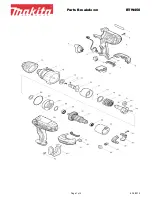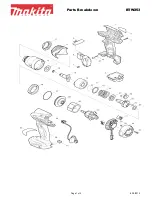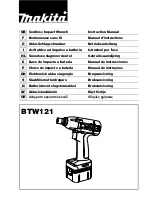
GB/
MT
limited space. Take care not to jam your
fingers between the equipment and the
workpiece. This applies in peculiar when
loosening screw connections.
■
Working with the equipment can result in
disorders in the hands, arms, shoulders,
neck and other parts of the body.
■
Before carrying out repairs and
maintenance work or changing and
adjusting tools, disconnect the equipment
from the compressed air source.
■
Use only original replacement parts.
■
Only use adapters and attachments that are
in good condition and intended for use with
the hammer screwdriver.
■
Do not use any defective items of
equipment.
■
Slipping, stumbling and falling are the main
reasons for injuries at the workplace.
Beware of slippery surfaces which result
from using the equipment and also beware
of tripping over the air hose.
■
Beware of hidden dangers such as electric
cables. Ensure that no electrical cables or
water pipes are damaged when working
with the equipment.
■
This equipment is not insulated against
contact with an electric cable.
It is vital to avoid all contact with electric
cables.
■
Do not use the hammer screwdriver in a
potentially explosive atmosphere.
■
Dust may be a health hazard for the person
operating the equipment. This applies to
dust being created and whirled up during
the operation of the equipment. Depending
on the material you wish to process, dusts
and gases may arise that are a health
hazard for the user (for example causing
cancer, birth defects, asthma and / or
dermatitis).
Wear a breathing mask.
■
Make sure that escaping air whirls up as
little dust as possible.
■
Noise can cause permanent damage to your
hearing. Unprotected exposure to high
levels of noise can result in loss of hearing
and other problems such as tinnitus (ringing,
buzzing, whistling or droning noises in your
ears). Wear ear-muffs. To keep noise and
vibration levels as low as possible, follow
the maintenance and operating instructions
in the manual. If required by the particular
situation, vibration-damping material used
as an intermediate layer can also reduce
noise.
■
Only use suitable plug-on attachments.
■
Vibrations can be transferred to the whole
body, particularly the arms and hands. Very
strong and continuous vibrations can cause
neural and vascular disorders. Regular work
breaks will minimize the risk of disorders
caused by vibrations.
■
Hold the equipment with a light but secure
grip, noting the reaction forces which arise
in the process. The risk of disorders caused
by vibrations is always greater with a tight
grip.
■
Wear warm clothing when you work in cold
surroundings. Keep your hands warm and
dry.
■
If you suffer pains or repeat symptoms while
using the equipment, do not ignore them but
consult a doctor.
■
Do not let cold air flow over your hands.
■
Compressed air can cause serious injuries.
■
Never direct escaping compressed air at
yourself or at any other person.
■
Disconnect the compressed air coupling
and depressurize the equipment before you
service, repair or transport the equipment
and before you change tools.
■
Do not carry compressed air tools by their
hose.
■
Never allow the tool to run unloaded at full
idle speed for an extended period of time.
■
The compressor and lines can become very
hot during operation. Touching these parts
will burn you.
■
The gas and steam sucked in by the
compressor must be kept free of impurities
that could cause fires or explosions in the
compressor.
■
Keep your hands away from the installed
tool (connector), to prevent injuries.
■
Only qualified and trained persons are
allowed to use this equipment.
■
Do not modify this equipment. Modifications
can impair the effect of the safety devices
and therefore increase the potential danger
42
Anleitung_LB5_4138944:_ 12.04.2011 15:36 Uhr Seite 42
















































